#cist burial
Text
Skeletons under the Floorboards: A Multiple Iron Age Burial in Applecross
by Cathy Dagg
The Background
In July of 2015 workmen renovating an old house in Applecross reported finding a human skull under the kitchen floor. They had, apparently, found other bones and thinking them to be animal, chucked them out. The skull initially looked like a cobble, similar to the cobbles that made the former storm beach that the house had been built on, but when it proved to be…
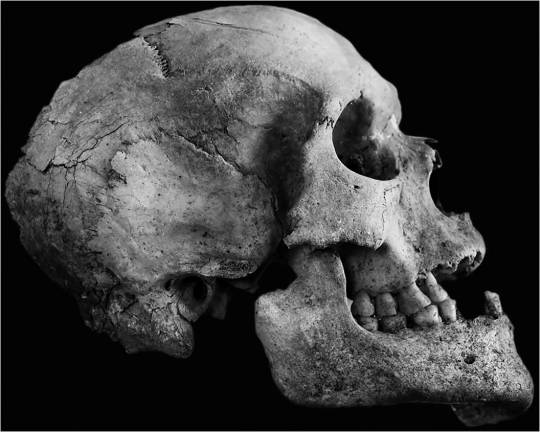
View On WordPress
#Applecross Archaeological Society#Applecross archaeology#Black Rocks Gullane#burial cairn#Cist Burial#East Lothian#excavating human remains#highland archaeology#Ian Armit#iron age human remains#Loch Borralie#Lochend#Lochend East Lothian#Michelle Williams Ward#North Belton Dunbar#palaeopathology#radiocarbon dates#Sangobeg
0 notes
Text


Reconstructed Prehistoric Beaker Burial In A Stone Cist, Dumfries Museum, Scotland
#ice age#stone age#bronze age#iron age#prehistoric#prehistory#neolithic#mesolithic#paleolithic#archaeology#beaker burial#burial chamber#burial ground#burial mound#prehistoric pottery#grave goods#ritual#relic#ancient cultures#ancient living#cist#cairn#Scotland#Dumfries
57 notes
·
View notes
Text

Ancient Greek-Roman Necropolis with Sarcophagus Avenue Found in Turkey
Archaeologists excavating the ancient city of Tios have uncovered a Roman necropolis featuring an avenue lined with sarcophagi.
Tios is an Ancient Greek colony, located on the south-western coast of the Black Sea near the modern Filyos Port in Zonguldak, Turkey.
Legend has it that the city was founded in the 7th century BC by a Milesian priest named Tios in the land of the Caucones, a Paphlagonian tribe.

Unlike many other Greek colonies along the Black Sea coast, Tios has remained relatively well-preserved in situ, with the archaeological record largely undisturbed by modern development.
Recent excavations, led by Professor Şahin Yıldırım from Bartın University, have uncovered a large necropolis on the eastern side of the city. Archaeologists have so far unearthed 96 sarcophagi, 23 chamber burials, 7 cist graves, 60 frame tile graves, and over 1300 funerary objects.
According to Professor Yıldırım, the necropolis covers a vast area and has burials dating from the 5th century BC to the 5th century AD, a period of burial activity that lasted a millennia.


The necropolis was most active around the 1st to 3rd centuries AD during the Roman period, emerging into a “city of the dead”. “We can see that the necropolis was constructed with a plan consisting of streets, alleys and terraces, just like a city,” said Professor Yıldırım.
Excavations have also revealed an avenue measuring approximately 500 metres, in which sarcophagi have been deliberately placed on its left and right flanks. The archaeologists suggest that these burials belonged to wealthy individuals, predominately from the 2nd to 3rd centuries AD.
“To date, no such necropolis examples of this scale have been encountered in any ancient city in the Black Sea region. This area holds a very important place for Türkiye and Black Sea archaeology,” added Professor Yıldırım.
By Mark Milligan.
#Ancient Greek-Roman Necropolis with Sarcophagus Avenue Found in Turkey#ancient city of Tios#Zonguldak Turkey#ancient tombs#ancient graves#ancient necropolis#funerary objects#ancient artifacts#archeology#archeolgst#history#history news#ancient history#ancient culture#ancient civilizations#greek history#roman history#roman empire
14 notes
·
View notes
Text
Teeny bit of AToTD worldbuilding
It is the custom of the desert people of Rafatan Pĭksel to bury their dead in a tomb that I've called a q'abrĭn.
Q’abrĭn = tomb
Note: This is a small cist-like tomb, constructed beneath the sands. Each person’s tomb location is calculated based on the positions of certain stars at the time of their birth and their death, and no two people will have the same location for their tomb. Some are close to the city and some are very far distant. Their tombs are not visited by family and friends. Instead, the deceased is remembered at the Vigil, as that is where their candle was burned.
Below is a public domain image of a reconstruction of a real life cist:

In the burial customs of A Tale of Two Devotions, the deceased would be placed in a foetal position within such a tomb, but no grave goods would accompany them. Instead, their possessions would be distributed among their family, friends, and others who might have more need of them.
#a tale of two devotions#atotd#empires smp#empiresblr#pixlriffs#empires pixlriffs#empires fanfic#mcytblr#mcyt#pixandria#the copper king#the phantom assassin
6 notes
·
View notes
Text
Megalithic Sites
A megalith is a huge stone that has been put to some type of purpose, typically between the Mesolithic through the chalcolithic period, fading out through the Bronze age. They can be single or multiple stones, though they are generally not tombs.
Single stones can come in three general types: Menhir, also know as 'standing stones', monolith (a single stone on its own), and capstones, which cover burial chambers without other supports. Multiple stones can come in five general types: Alignments which can be rows or spirals, megalithic or Cyclopean walls, which are rough-hewn bolder walls, stone circles or cromlechs like Stonehenge, dolmen which can be called a portal tomb and are table like entrances into tombs, and cist which is a stone coffin.

By German Archaeological Institute, photo E. Kücük. - Dietrich L, Meister J, Dietrich O, Notroff J, Kiep J, Heeb J, et al. (2019) Cereal processing at Early Neolithic Göbekli Tepe, southeastern Turkey. PLoS ONE 14(5): e0215214. https://doi.org/10.1371/journal.pone.0215214Image: https://journals.plos.org/plosone/article/figure?id=10.1371/journal.pone.0215214.g001"Copyright: © 2019 Dietrich et al. This is an open access article distributed under the terms of the Creative Commons Attribution License, which permits unrestricted use, distribution, and reproduction in any medium, provided the original author and source are credited." (links to CC BY 4.0 the day the picture is uploaded), CC BY 4.0, https://commons.wikimedia.org/w/index.php?curid=90543136
Humans began building large stone structures even before we began living in cities. Some of the earliest are around the area of Gobleki Tepe in modern day Turkey, which were built around 9000 BCE by a culture that we don't know what they call themselves and first rediscovered in 1963. It wasn't until about 1994 that the excavations began. These sites consist of many large stones that are decorated with male figures and animals. Because these sites predate writing, we don't know what the purpose was, but we can tell by what refuse is around that these sites were not for full-time shelter. Because of this, we believe that they held ceremonial significance. However, with less than 5% of the site excavated, we still have a lot to learn about this site, though we have learned so much already.

By Mahmut Bozarslan (VOA) - https://d33vxfhewnqf4z.cloudfront.net/a/tarihin-yeni-sifir-noktasi-karahantepe/7351113.html, Public Domain, https://commons.wikimedia.org/w/index.php?curid=145335567
Nearby, there is a site called Karahan Tepe that was discovered more recently that might be older, possibly dating as far back as 11000 BCE. It also includes area where the stone for the megaliths was quarried. It was first rediscovered in 1997. It hasn't been as excavated or studied as much as Gobekli Tepe, however it appears to have been intermittent in habitation, possibly following herds of grazing animals and availability of wild growing grasses such as barley and wheat.

By Hanay, CC BY-SA 3.0, https://commons.wikimedia.org/w/index.php?curid=15044109
Atlit Yam is a site one kilometer off-shore from modern day Atlit. At the time it was built, approximately 6900 BCE, during the last Ice Age, the location was on the shore. There is a large stone semicircle that would have been around a freshwater spring. This site also has what appear to be houses as well. Around 6300 BCE, Mount Etna appears to have a collapse of its eastern flank that likely led to 40m tsunami in the Mediterranean. There were piles of fish and other evidence of rapid evacuation of the site. Within the site, there is also a woman and child that appear to have had tuberculosis, the earliest known cases, as well as men who have inner ear damage that indicate that they probably dived to fish and that the water was likely cold. There is evidence that this was one of the earliest sedentary cultures with grain storage and what appear to be wells, before it was abandoned to the tsunami and sea-level rise of the end of the last Ice Age.
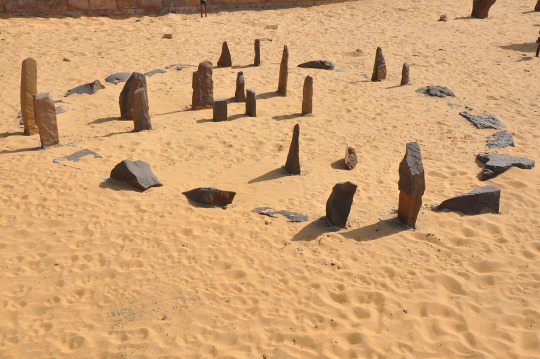
By Raymbetz - Own work, CC BY-SA 3.0, https://commons.wikimedia.org/w/index.php?curid=7525976
Another pre-agriculture seasonal megalithic habitation is Nabta Playa in modern day Egypt. While the location is now within the Sahara Desert, at the time, it was a rich savanna with a lake nearby. Archaeological findings suggest that people began camping there seasonally around 10000-9000 BCE. The megalithic structure was probably built around 7500 BCE, The megalithic site seems to be a "calendar circle", though there is some debate about that. Given that the exact alignment of the stars and seasons has shifted over the past 12000 years, it's difficult to know for sure which constellation the stones align to and which season, but they do seem to align with the bright stars in the constellation Orion. There are suggestions that the site was used as a ceremonial gathering site prior to the building of the stone circle based on the remains of cattle found in the location. It's believed, based on modern nomadic cultures, that cattle would have only been killed on important occasions.
Resources:
Milo Rossi (miniminuteman on YouTube and tiktok):
Series on Archaeology of Southern Turkey
Series regarding Netflix's Ancient Apocalypse
#megalith#megalithic sites#gobleki tepe#karahan tepe#nabata playa#atlits yam#prehistory civilizations#neolithic civilizations
3 notes
·
View notes
Text
Machrie Moor Standing Stones
The rich archaeological landscape of Machrie Moor on the isle of Arran, includes stone circles, standing stones, burial cairns and cists, as well as hut circles and an extensive field system, all dating to between 3500 and 1500 BC.
My artwork of three of the standing stones is available to collectors…

#Original Art#drawing#Pastel Painting#Oil Pastel#Oil Pastel Artwork#painting#artwork#art#Traditional Art#Scottish Artist#Made In Scotland#Landscape#Landscape Painting#Scotland#Arran#Machrie Moor#Gift Ideas#Etsy
4 notes
·
View notes
Text
Archeology tutor: This is a cist grave it was a ancient burial technique
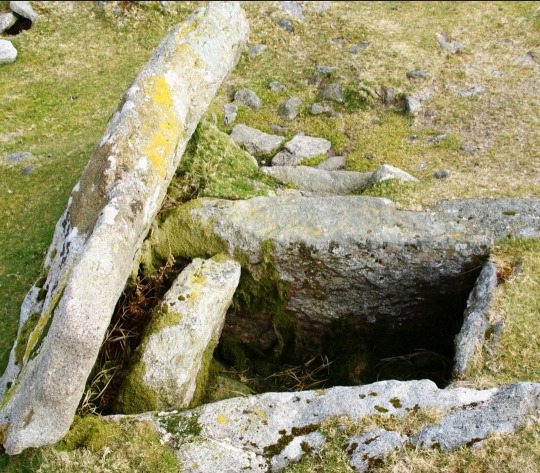
(Me in my head hearing cis): Ah yes this is were the straights were buried
2 notes
·
View notes
Photo

The Battle Axe Culture on Bornholm
Bornholm was influenced by the cultural development that took place in southern Sweden; a development that in many ways can be compared to the changes occurring in Jutland and the east of Denmark around 2800 BC. The Single Grave Culture’s neighbour to the east was called the Battle Axe Culture or the Boat Axe Culture, named after its boat-shaped battle axes made of stone. Substantial areas of land were also cultivated on Bornholm. Stone cists were used for burials.
The Danish National Museum
2 notes
·
View notes
Text
Wk 16, 25th of May, 2024
Research
Folklores of the Nine Ladies

The Nine Ladies is located on Stanton Moor

Illustration of the Nine Ladies in the 1872 book Rude Stone Monuments.

Offerings left in the centre of the Nine Ladies, evidencing modern Pagan ritual activity at the site
From the text: NINE LADIES STONE CIRCLE by English Heritage...
The Nine Ladies is a stone circle located on Stanton Moor in Derbyshire in the English East Midlands. The Nine Ladies is part of a tradition of stone circle construction that spread throughout much of Britain, Ireland, and Brittany during the Late Neolithic and Early Bronze Ages, over a period between 3300 and 900 BCE. The purpose of such monuments is unknown, although archaeologists speculate that the stones represented supernatural entities for the circles' builders.
Parking: The roads adjacent to Stanton Moor, where Nine Ladies Stone Circle is located, are very narrow and not suitable for parking on. Formal car parking is available just outside of Birchover, about 1.5km from the circle. What3words location: ///decorator.parsnips.saddens (Grid reference: SK 24113 62460).
Access: The site can be accessed via a number of footpaths depending upon your start point. They pass through fields and woodland with gates, stiles and uneven surfaces, which can be challenging, particularly for wheelchair users or buggies.
Facilities: There are no facilities on site.
Camping: Camping is absolutely prohibited on the moor. There are formal campsites nearby.
Dogs: Dogs on leads are welcome but must be kept under close control as there may be animals grazing.
More than 70 stone cairns and barrows are known, and excavations over the past 100 years have demonstrated that many served as places of burial. The most evocative and well-known of these monuments is the Nine Ladies Stone Circle and the King Stone, set 40 metres (131 feet) to the west-south-west of the circle.
Despite the name, there are 10 stones within the circle, the tenth (which has fallen and now lies flat) having been located in 1977. The stones are set on the inner edge of a slight bank, and form a ring which measures 11.5 x 10.5 metres (38 x 34 feet). The monument was first recorded by Major Hayman Rooke in 1782. He noted that there appeared to be stones in the centre of the ring, which may have formed a small cairn or ‘cist’.
The names of the monuments derive from their associations with folk traditions, in which it is said that nine women were dancing on the Sabbath to a fiddler – the King Stone – and were turned to stone. The graffiti carved on the King Stone, which includes the name ‘Bill Stumps’, is also mentioned in The Pickwick Papers by Charles Dickens.
In common with many other stone circles, little evidence has been uncovered to suggest why or when this stone circle was built and how it was used.
Suggestions include a place for ceremony or burial, a territorial marker, a perceived link between the earth and the sky and the living and the dead, or a meeting place for seasonal events. Such monuments may have had many functions, their uses and perceived significance shifting over time.
From the text: Modern Fairy Beliefs by Carolyn Emerick…
In the Middle Ages, people believed that certain unusual phenomena in nature could be doorways or portals to other realms. We forget that our modern lives are filled with entertainments and distractions that our ancestors didn't have. So while we are indoors staring at our televisions and computers, our ancestors were outdoors observing nature.
People of previous eras were very aware of natural occurrences such the shift of time. It was believed that odd times of the year, such as solstices and equinoxes, cause the veils between worlds to become so thin that beings from other realms could slip through. Not only could fairies, goblins, ghosts, and other creatures slip into our world, but it was said that humans could be taken away into their world as well.
0 notes
Text
youtube
Following discussion with Jamie and Janet about collab and inspired by Fictional Landscapes .From Canmore I found 2 local prehistoric cist sites near me , 1 in West Kilbride and 1 in Largs. Went to each site and took series of moving images. Stayed in each place thinking about then and now , no trace apart from a insert on Canmore and links to archaeological index from the 1800's and the 1970's. The site in Largs appeared from the records a significant number of human remains and death / burial architecture. I contrasted my experience from being in ORkney and the way that the island has held these ancient sites close and and protected. Mirroring in the contemporary landscape some of the ways that these prehistoric funerary sites were placed in ORkney as an ongoing engagement with the dead. Possibility that the dualisims held today : nature / culture , human /non human . living / dead didn't exist as a conceptual or ideological way of thinking.
I then put together some of the moving images and then responded in writing / poetry. Adding the spoken word to the collated images.
I will leave for a couple of days then come back to write to what emerges as embodied knowledge , strands to research more.
0 notes
Text
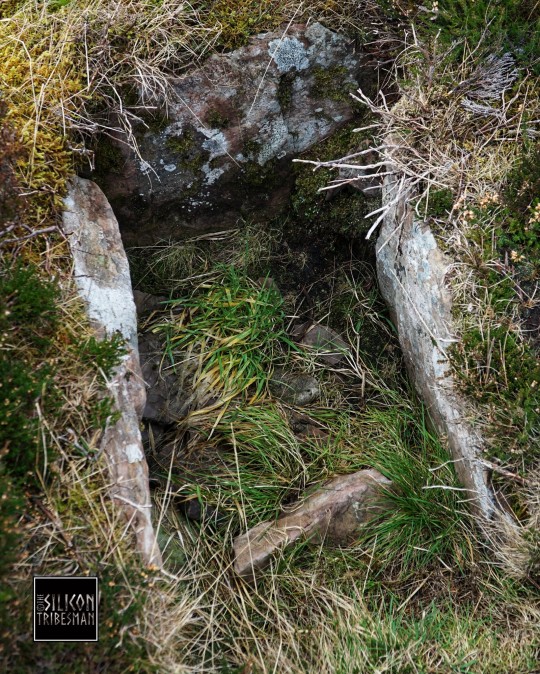
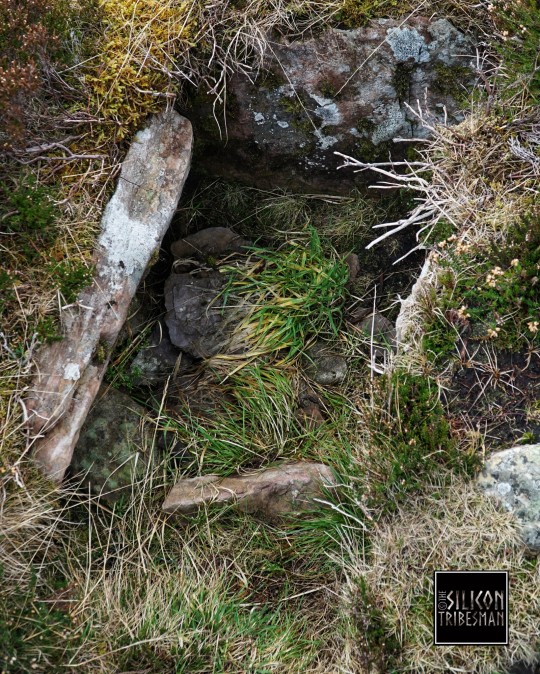

'Cairn O' Get' Prehistoric Cist Cairn, Caithness, Scotland
#ice age#stone age#bronze age#iron age#copper age#prehistoric#prehistory#neolithic#mesolithic#paleolithic#calcholithic#archaeology#relic#cist#cist cairn#cairn#burial chamber#burial mound#burial ground#ancient cultures#ancient living#ancient craft#caithness#Scotland#wild places
73 notes
·
View notes
Photo
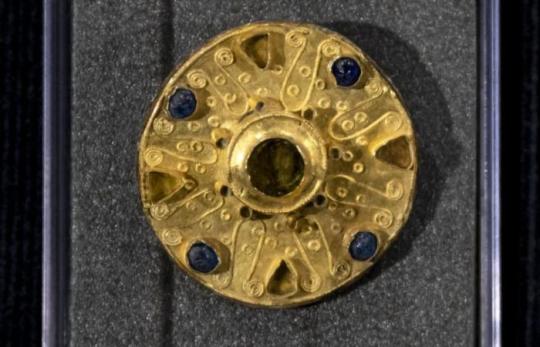
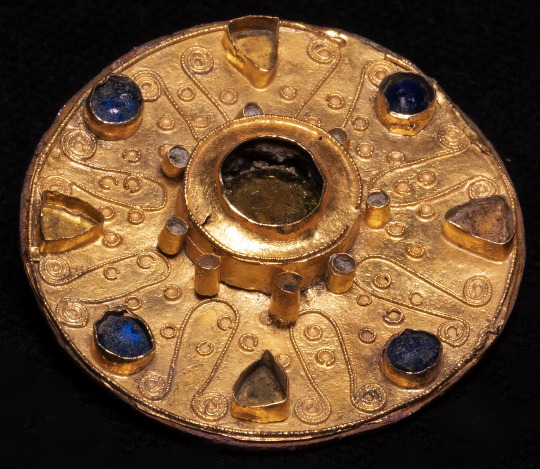
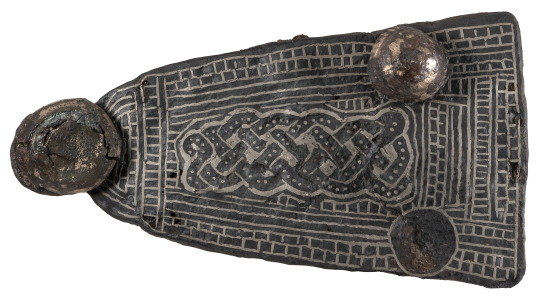
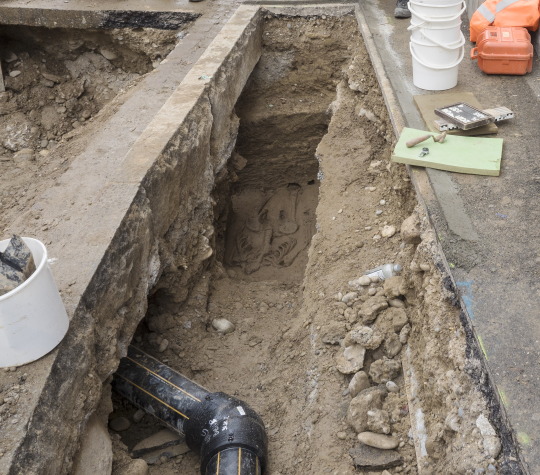
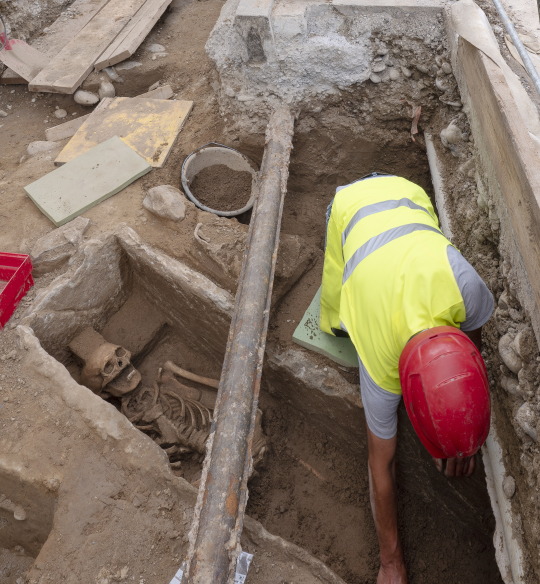

Medieval Tombs with Gold Jewelry Found in Switzerland
An excavation of the Kleinbasel neighborhood of Basel, Switzerland, has brought to light 15 graves, some of them richly furnished, from an early medieval burial ground. The presence of a burial ground from this period had been known since the 19th century, so a rescue archaeology excavation was undertaken in the area before installation of new utility pipes. Earlier this year the excavation unearthed the 6th century grave a young girl buried with a dazzling array of about 380 beads. The recent discoveries prove that the cemetery was more densely populated than archaeologists realized.
One of the highlights of the newly-discovered graves is that of an elite young woman who was about 20 years old when she died in the 7th century. The grave was damaged during construction in the early 20th century. The skull is lost, as is the body below the knees, but the riches she was buried with remain. The grave contained a rare gold disc brooch made of a base plate made of a non-ferrous metal that was then topped with gold. The disc was then adorned with gold wire filigree and inlayed with green garnet gemstones and blue glass. The brooch likely held together a cloak, now gone, at her neck. She was also wearing a necklace made of 160 glass, amethyst and amber beads (or had them sewn onto the collar or bodice of her garment). There was also a leather strap decorated with metal crosses that terminates in a large amber pendant. Around her waist was a belt with an iron buckle and a silver tongue. Hanging from the belt was a chatelaine with pierced Roman coins, metal artifacts and a bone comb.
Other notable graves found in the current excavation include a child’s grave containing a large silver inlay belt buckle, metal belt fittings, scissors and a comb, and a stone cist grave containing the skeleton of an adult man. The man’s face bears the unmistakable evidence of violent blow from a sword. Amazingly, the man survived the disfiguring injury as he died after it was fully healed.
Basel was founded as a Celtic oppidium, or fortified settlement, in the 1st century B.C. The Romans built a military camp on the site of the settlement and by the end of the 1st century A.D., it was absorbed into the Roman province of Germania Superior. Roman control weakened in the 3rd century, but the troops along the Rhine managed to repel invasions from the Germanic Alemanni confederation several times in the 4th century. The Alemanni finally won around 406 A.D., settling throughout the Swiss Plateau. They and the Franks after them occupied the old Roman castle and the town’s fortunes were revived. It was minting its own coins in the 7th century and was made a bishopric in the 8th. The Roman castle was converted into Basel’s first cathedral. What is today the Kleinbasel area was the castle/cathedral hill, the nucleus of the early medieval settlement.
#Medieval Tombs with Gold Jewelry Found in Switzerland#basel switzerland#ancient tombs#ancient graves#ancient artifacts#gold#jewelry#history#history news#ancient history#ancient culture#ancient civilizations
175 notes
·
View notes
Photo

‘On Whitehorse Hill’ Poem
Written by The Silicon Tribesman. All Rights Reserved, 2019.
#whitehorsehill#bronzeage#cist burial#cist cairn#prehistory#prehistoric#dartmoor#grief#poemsaboutlove#poets of tumblr#poetry#poetic#poetry of loss#poetry of death#poems about death#megalithic#cairn#creative#education#cross arts#cross curricular#community#identity#belonging#ritual
44 notes
·
View notes
Photo
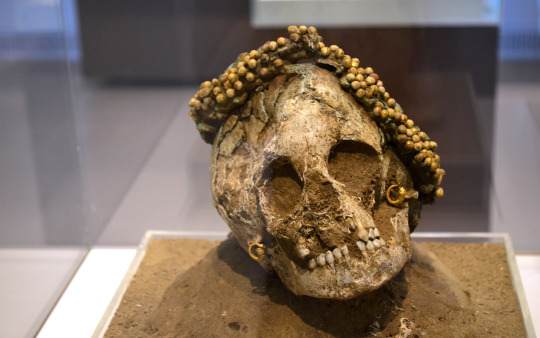

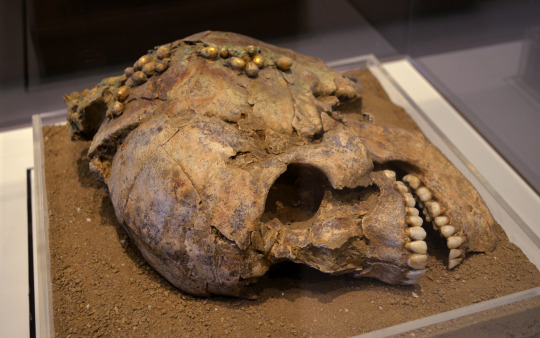
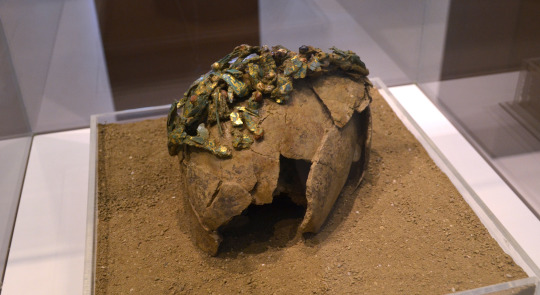
Archaeological Museum of Patra:
Four crowned skulls of two little girls, and two women, from the North Cemetery in Patras, from the Hellenistic Period.
The first skull bears a wreath of gilded myrtle fruits. The deceased wore golden earrings. (300-275 B.C)
The second skull bears a wreath of fruits and myrtle flowers. The flowers are earthen, some gilded and others in a variety of colors. (late 4th-3rd cent. B.C)
The third skull bears a gilded myrtle wreath, where apart from the leaves, some of the small fruits have survived as well.
The fourth skull is also decorated with a gilded myrtle wreath. The shaft is made of lead and has been also perforated. Gilded bronze leaves and earthen fruits were attached to the small holes.
A detail from the heads of the two little girls. Damages to the skulls might have occured posthumously- it was not specified in the tags.


I have seen many luxurious funerary wreaths, made of gold, with extraordinary craftmanship, they are a particular trait of the burials of the Hellenistic period, and these burials were of particularly wealthy, aristocrats of the (Greek) Macedonian elite, usually families of soldiers associated with the campaigns of Alexander the Great. They were discovered either in ornately painted built tombs, under raised mounds, or well built cist graves, who often would also be decorated with painting.
But these burials of commoners, those wreaths of painted, clay flowers are the most touching of them all. It just shows you the exceptional love and care that existed in those ancient families.
#ancient greece#tagamemnon#archaeology#tw: human remains#human remains#skull#funerary wreaths#wreaths#greece#greek museums#museums#archaeological museum of patra#patra#funerary customs#ancient burials#burial customs#child burials#tw: death#tw: child death#ancient art#αρχαία ελλάδα#ελλάδα#πάτρα#ταφικά έθιμα#στεφάνια ταφής#ελληνιστική περίοδος
6K notes
·
View notes
Text
'Untouched' Bronze Age tomb containing human remains and a mysterious stone found in Ireland
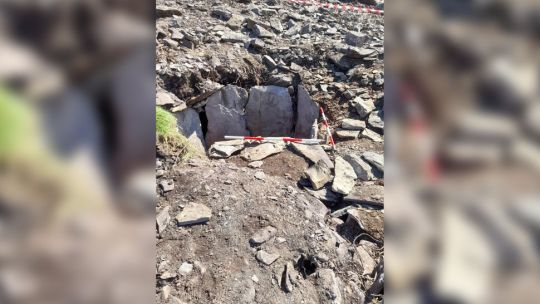
An ancient tomb thought to date back more than 3,000 years has been discovered in southwest Ireland by workmen carrying out land improvements on a farm.
Archaeologists say the tomb on the Dingle Peninsula of County Kerry is "untouched" and that some of its unusual features, including a mysterious oval-shaped stone inside, indicate that it could be an early example of an ancient burial.
The tomb appears to be a "cist" or chamber tomb, consisting of an underground stone-lined structure built to contain one or several burials and capped with a large stone, Ronan Casey, a spokesperson for Ireland's National Monuments Service, told Live Science. Read more.
347 notes
·
View notes
Photo

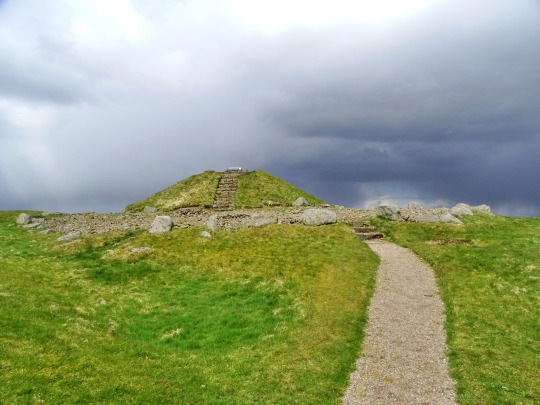
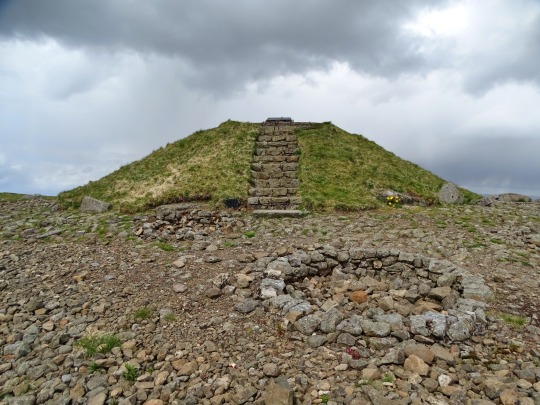
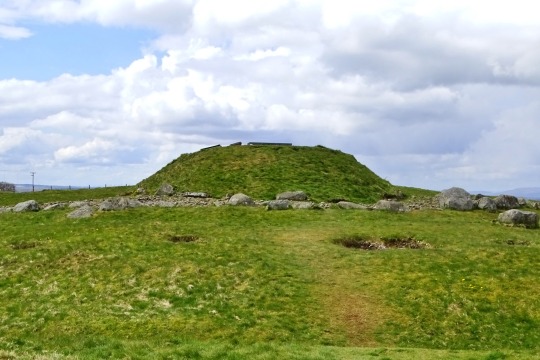
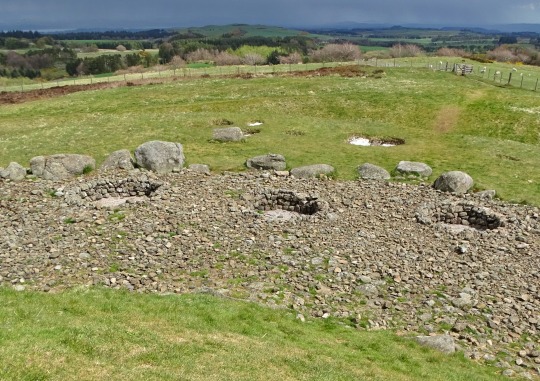



Cairnpapple Hill.
Cairnpapple has been on my radar for some time, since I made a visit to nearby Torphichen Preceptory just over three years ago, thanks to Frank Stewart for taking me here last week.
This area covers many different eras, starting with the henge that dates from about 3800 BC. Centuries later the landscape was chosen for a number of Bronze Age burials. Much later still, it was used for early Christian graves, if you bring it right up to todays tourist attraction that's around 6 thousand years, that's older than the likes of Stonehenge and the Pyramids.
Cairnpapple Hill is one of the best-known prehistoric sites in mainland Scotland. Its prominence in the landscape and the fine views from its summit are at least partly why this particular location developed into such a special place.
Professor Piggott of the University of Edinburgh excavated the site in 1947–8, uncovering the henge monument and later burials across the summit of the hill. Cairnpapple had been the focus of communal activity for more than 200 generations of local farmers, and the landscape is still peppered with farms, and indeed a new "henge" as seen in my pics from yesterday, built by another local farmer.
Finds on the site include two stone-axe fragments from axe "factories" in Wales and Cumbria. Clearly the early Neolithic farmers of West Lothian didn’t lead isolated lives. The hearths are no longer visible, as they were covered by the henge monument – a great oval earthwork enclosure – built in the later Neolithic period, unfortunately it was closed last week, but Frank says he will take me back some day and hopefully get a look inside the mound.
The henge at Cairnpapple had a bank 60m across, surrounded by a broad ditch, which enclosed a ring of 24 upright timber posts. The timber hasn’t survived, but the post holes are clearly visible. There were two entrances to the henge, almost directly opposite each other.
The henge ceased to be used for ceremonial purposes about 4,000 years ago, during the early Bronze Age. But the local people clearly still revered it, as they buried an important member of the community there.
This first burial place was marked by an oval setting of stones, with a single large standing stone at its head. The body had been buried with a wooden mask covering the face. Two Beaker pots left alongside had probably been filled with food and drink to sustain the dead person on the journey to the afterlife.
Two burial cists were added later. These were stone-lined pits with a single massive capstone on top. A food vessel was found in one and a single human cremation in the other. One cist bore three cup-marks pecked into the surface. These burials were covered by a stone cairn, which was neatly edged with 21 kerb stones.
A skeleton and artefacts found at Cairnpapple can be found in the National Museum of Scotland, Edinburgh.
260 notes
·
View notes